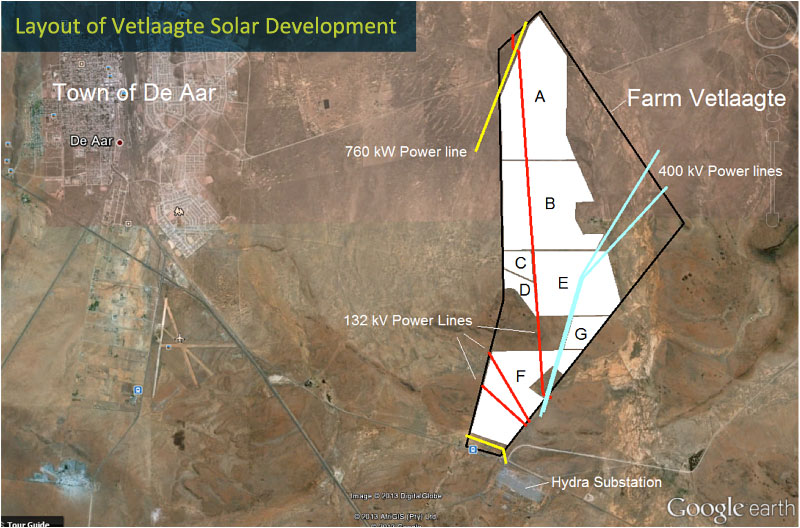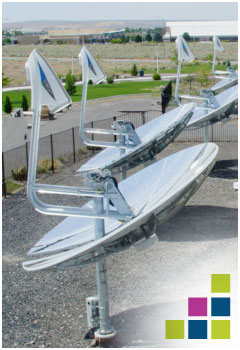Vetlaagte Solar Development
Ennex has recently completed the permitting of a solar development on the farm Vetlaagte near the town of De Aar in the Northern Cape province of South Africa. The development will consist of seven utility scale solar power projects with a total capacity of 315 MW, which will make it one of the largest solar developments in the Southern hemisphere. Four of the projects will be 75 MW each while three of the projects will be 5 MW each. The advantages of the specific site are:
- Good grid access being located next to Eskom’s Hydra substation;
- Suitable flat terrain;
- Excellent road access;
- Excellent solar resource, 2222 kWh/m2 on horizontal surface;
- Close to the town of De Aar for employee accommodation;
- All necessary permits and approvals in place. These include:
- Long term lease agreement;
- EIA completed for development as a whole with Environmental Authorization (EA) issued for all 7 projects in the name of separate project companies (SPVs);
- Rezoning approved;
- Grid connection cost estimates from Eskom for all 7 projects;
- Pre-application of water use licenses submitted to DWA – letters issued.
- Square Kilometer Array (SKA) approval;
- Civil Aviation Authority (CAA) approval;
- Section 53 Approval (Mineral Rights);
- Approval from Department of Agriculture, Forestry and Fisheries (DAFF) for the long term lease of project areas.
The Environmental Authorizations (EA) cover the following technologies: PV, Tracked PV, CPV and dish Stirling.
The project area, capacity and operating company of the different facilities area as follows:
Portion |
Ha |
MW |
Operating Company |
Status |
A |
250 |
75 |
Ennex Solar (Pty) Ltd. |
Available |
B |
232 |
75 |
Nexergy Solar (Pty) Ltd. |
Available |
C |
20 |
5 |
Inqwaba Energy (Pty) Ltd. |
Available |
D |
20 |
5 |
Khaliphile Energy (Pty) Ltd. |
Available |
E |
168 |
75 |
Ukuqala Solar (Pty) Ltd. |
Sold |
F |
174 |
75 |
Lehlasedi Energy (Pty) Ltd. |
Available |
G |
32 |
5 |
Ikusasa Energy (Pty) Ltd. |
Available |
A bid has been submitted for one of the projects in Round 3 of the Department of Energy’s IPP programme (http://www.ipprenewables.co.za).


Feasibility study: 20 MW Dish Stirling Concentrated Solar Power Plant
Among thermal CSP technologies dish Stirling systems offer the highest conversion efficiency. However, the first generation dish Stirling systems utilized a complex kinematic Stirling engine, which was not only expensive but was also prone to breakdowns and which resulted in high maintenance costs. Great progress has been made over the last decade in the development of a dish Stirling system based on the free-piston Stirling concept, which is significantly more simple and reliable than kinematic Stirling engines. Other unique features of this system are no need for water, very high reliability, high efficiency, low environmental impact, minimum use of land area, rapid deployment and modular approach which makes this technology suitable for projects from 3 kW to 300 MW+. The project will entail the erection of a 20 MW PowerDishTM Stirling CSP power plant in South Africa.
The reasons why we investigated the feasibility of a PowerDishTM Stirling CSP plant system are:
- High average conversion efficiency of about 20%;
- High average utility factor of about 32%;;
- No need for water to cool the system;
- Extremely high reliability;
- Low operating and maintenance costs;
- Proven technology;
- No need for flat terrain;
- Small lead time, equipment can be delivered within 6 months after placement of order;
- Modular approach which means that the technology is suitable for plant capacities ranging from 3 kW to 300MW+;
- Low construction interest as blocks of 1 MW or more can be commissioned and connected to the grid. This implies rapid generation of income.
- Small environmental impact - no need to clear vegetation and small farm animals can still graze on the land;
The study showed that the LCOE of the PowerDishTM compares favourably with that of PV plants, especially in warm climates with a high direct solar irradiation (DNI).
|






